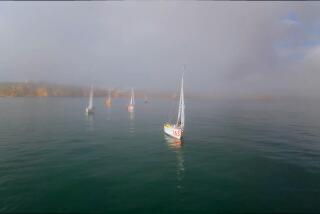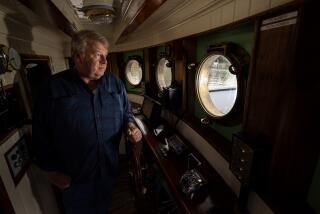A Bottleship Navy Is His Specialty
- Share via
“Even a klutz can do it,” says Howell Thomas--which seems unlikely, but there you are.
On the heel of Thomas’ steady hand is a bottle less than 3 inches long; inside the bottle is an exquisite, detailed scale model of a sailing ship, more than 2 inches long. The masts of the ship are easily three times higher than the neck of the bottle is wide, and therein lies a tall tale.
It took Thomas 12 years to make his first ship-in-a-bottle. You can do it in a month, he insists, “a pretty good quality ship too.” The difference is, Thomas had no teacher; you can have one: Thomas.
The “maritime arts” they call them--bottled ships and scrimshaw (carving on bone, ivory or wood)--and two L.A. museums, Natural History and Maritime, are co-sponsoring classes in both.
Teach the Hoary Craft
Thomas will teach the hoary craft of ships-in-a-bottle; Joe Cocke will instruct in scrimshaw. Both work at the Natural History Museum; both classes will be held at the Maritime Museum in San Pedro, starting next week.
The arts originated centuries ago with sailors, who had the time, the material and the bottles. (The grog ration remains one of the nobler staples of the Royal Navy, though Thomas cautions against starting the project immediately after emptying the bottle.)
“The oldest documented ship-in-a-bottle is from 1784,” Thomas says, looking up from his work (this one a whaler inside a 2-foot triangular bottle, along with a miniature fisherman who’s hooked the world’s smallest whale from a diminutive dinghy). “Popularity kind of died down in the early 1900s, but there’s been a revival recently.”
Thomas has made more than 50 vessels, including a clipper ship launched way down in the hold of a Chianti bottle with a 4-foot neck, but not counting a Mississippi paddle boat now in the planning stage. (“That’s going to be tough,” he concedes: “I’ll have to build it first, then take it apart, then rebuild it in the bottle.”)
The splendidly shaggy paleontologist insists, though, that the pastime “doesn’t take a lot of hand-eye coordination, just a willingness. If you can tie a knot and snip a scissors, you can build a ship-in-a-bottle.”
Rewards can be financial (Thomas sells a few ships a year to fanciers) but are mainly psychic.
“It’s a great curiosity piece,” he says. “Most people haven’t a clue as to how it’s done. It’s magic! How did that get in there ? Someone walks into your living room and sees one and bang! You’re off on a long conversation. When they find out that you did it. . . .” The sentence trails off, truncated by an easy grin as wide as an estuary.
Of necessity, the untutored shipwright has created his own tools--long, skinny, ingenious--and works from a tool box laden with Lilliputian drill bits, beads, a lot of stuff that has no name, because he invented it.
Generally, he uses soft pine for the hull, mahogany strips for spars and for masts--toothpicks. Thomas has a slim book out--”Ships Into Bottles: A Guide for Beginners,” available at his classes for $5--but “just as a starter book. There’s really no limit as to what you can do. The bottle can be a 1-incher or a 5-gallon jug. I’ve seen people do cars, airplanes, houses, even ships-in-bottles-in-bottles, if you see what I mean.”
Still, Thomas’ all-time favorite is an enterprise created by the late Jack Needham, an Englishman. Somehow, some way, Needham put into a small bottle the smaller figure of a tiny man seated at a tiny desk who’s just finished a minuscule ship in a minuscule bottle.
“Now there’s a project,” Howell Thomas says, “something maybe for your retirement years.
“If you mess up (while tugging the threads that erect the ship inside the bottle), you’ve got to deep-six the whole mess, but that’s nothing compared with the satisfaction of succeeding. The more I learn, the more fascinating it is. Hey, what can I tell you? All I know is that it keeps me sane.”
Ships-in-Bottles class, starting this week, will be held Wednesdays, 7-9 p.m. Cost: $55. Joe Cocke’s scrimshaw class meets Thursdays, Feb. 16-March 9. Cost $50. Maritime Museum is on San Pedro waterfront at foot of 6th Street, next to Ports o’ Call shopping village. For information, call (213) 548-7618, or Natural History Museum at (213) 744-3342.
More to Read
Sign up for The Wild
We’ll help you find the best places to hike, bike and run, as well as the perfect silent spots for meditation and yoga.
You may occasionally receive promotional content from the Los Angeles Times.






